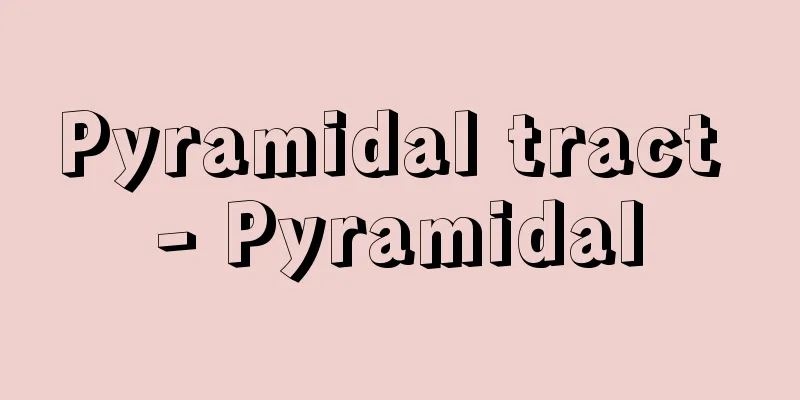Pyramidal tract - Pyramidal

|
The pyramidal tract is a nerve pathway that controls voluntary movements that require precise skill, and is first found in the central nervous system of mammals. It is named after the fact that this nerve tract passes through the inside of a pyramid that bulges on the ventral side of the medulla oblongata. The pyramidal tract consists of two systems: the corticospinal tract and the corticonuclear tract. The corticonuclear tract is sometimes called the corticonuclear fiber because its route has not yet been clearly understood. The neurons that start the pyramidal tract are thought to be the pyramidal cells of the cortex of the left and right cerebral hemispheres, such as the precentral gyrus (Brodmann area 4) of the frontal lobe, which is considered to be the primary motor center, the gyrus anterior to that, which is the secondary motor center (Brodmann areas 6 and 8), and the postcentral gyrus (Brodmann areas 3, 1, and 2) of the parietal lobe, which is considered to be the primary sensory center. In particular, the fifth layer of the cortex of the precentral gyrus contains the giant pyramidal cells of Betz (named after the 19th century Russian anatomist VA Betz), and it is certain that the nerve fibers of these giant pyramidal cells participate in the pyramidal tract. Looking at the path of the pyramidal tract on one side, the corticospinal tract first has nerve fibers emerging from the pyramidal cells of the cortex passing through the center of the internal capsule of the diencephalon, then passing through the center of the cerebral peduncle (narrow sense) of the midbrain, and then passing through the base of the pons (basal pons) of the hindbrain in a dispersed manner. It then descends to the medulla oblongata, where the fiber bundles converge again at the lower end of the medulla oblongata, with 80-90% of the fibers passing through the spinal cord on the opposite side. In other words, the left and right corticospinal tracts cross (pyramidal cross) at the lower end of the medulla oblongata. After crossing, the corticospinal tract that emerges on the opposite side of the spinal cord descends through the white matter called the lateral spinal cord and gradually ends up in the motor anterior horn cells of the spinal cord. This pathway is called the lateral corticospinal tract. 10-20% of the fibers of the corticospinal tract do not cross pyramidalis, but instead descend into the anterior funiculus of the spinal cord on the same side. This pathway is called the anterior corticospinal tract. This descending pathway also ends in the anterior nucleus cells on the opposite side. Therefore, the left and right corticospinal tracts are ultimately crossed, and if cerebral hemorrhage occurs in the internal capsule through which the corticospinal tract passes, voluntary motor paralysis occurs on the opposite side of the injury. The other corticospinal tract descends together with the corticospinal tract, but mainly ends in the motor cranial nerve nuclei (a group of motor nerve cells) in the brainstem on the opposite side. However, its course is still unclear. It is said that there are about one million nerve fibers in the pyramidal tract that pass through one pyramid of the human brain. [Kazuyo Shimai] Source: Shogakukan Encyclopedia Nipponica About Encyclopedia Nipponica Information | Legend |
|
精緻(せいち)で熟練を要するような随意運動をつかさどる神経伝導路で、哺乳(ほにゅう)動物になって初めて中枢神経内にみられる。錐体路という名称は、この神経路が延髄腹側面に膨隆している錐体の内部を集中的に通過することから名づけられた。錐体路は皮質脊髄(せきずい)路と皮質核路の2系統からなっている。皮質核路はまだその走行経路が確実に把握されていないため、皮質核線維とよぶ場合もある。錐体路の始まりとなる神経細胞は左右の大脳半球にある第一次運動中枢とされる前頭葉の中心前回(ブロードマンの4野)、その前方の第二次運動中枢のある脳回(ブロードマンの6、8野)、第一次感覚中枢とされる頭頂葉の中心後回(ブロードマンの3、1、2野)などの皮質の錐体細胞と考えられている。とくに中心前回の皮質の第五層にはベッツの巨大錐体細胞(19世紀のロシアの解剖学者ベッツV. A. Betzにちなむ)があり、この巨大錐体細胞の神経線維が錐体路に参加していることは確実である。一側の錐体路の経路についてみると、まず皮質脊髄路は、皮質の錐体細胞から出た神経線維が間脳の内包の中央部を通過し、ついで中脳の大脳脚(狭義)の中央部を通り、後脳の橋(きょう)の底部(橋底部)を分散して通る。さらに延髄へと下行し、延髄の錐体に至ってふたたび集束した線維束は、延髄下端でその80~90%の線維が反対側の脊髄に移る。つまり、左右の皮質脊髄路は延髄下端で交叉(こうさ)(錐体交叉)することになる。交叉後、脊髄の反対側に出た皮質脊髄路は、脊髄側索とよぶ白質部を下行しつつ、しだいに脊髄の運動性前角細胞に終わる。この経路を外側(がいそく)皮質脊髄路とよぶ。皮質脊髄路のうち、10~20%の線維は錐体交叉をせず、そのまま同側の脊髄前索とよぶ白質を下行する。この経路を前皮質脊髄路とよぶ。この下行路も結局は反対側の前核細胞に終わる。したがって、終局的には左右の皮質脊髄路は交叉性であり、皮質脊髄路が通る内包で脳出血がおこると、傷害部と反対側の随意運動麻痺(まひ)がおこることになる。もう一方の皮質核路は皮質脊髄路とともに下行するが、おもに反対側の脳幹内にある運動性の脳神経核(運動性神経細胞の集団)に終わる。しかし、その走行はまだ不明確である。ヒトの一側の錐体を通過する錐体路の神経線維数は約100万本とされている。 [嶋井和世] 出典 小学館 日本大百科全書(ニッポニカ)日本大百科全書(ニッポニカ)について 情報 | 凡例 |
>>: Extrapyramidal tract - Suitai-iro
Recommend
"Medical Records" - Isekikou
…His eldest son Yuanxin (Xiaohu) succeeded him. H...
Ambulance personnel - ambulance crew
…Emergency medical care includes the following: (...
Aiaiē (English spelling) Aiaie
… Greek goddess. Daughter of the sun god Helios, ...
Korean Socialist Party
...He later fled to Manchuria and Siberia, where ...
Antonius (of Padua)
1195‐1231 A saint and Doctor of the Church who die...
Hosta plantaginea (English spelling)
… [Noboru Fujita]. … *Some of the terminology tha...
bipinnaria
…However, some starfishes nurse their young for a...
Beyle, H.
…French novelist. His real name was Henri Beyle. ...
Velasco Ibarra (English)
1893‐1979 Ecuadorian politician. Born in Quito, he...
Mount Sumeru
A giant mountain at the center of the world in Bu...
Cœdès, Georges
Born: August 10, 1886 in Paris [Died] 1969 French ...
Thermocolor
…A paint whose pigment is a compound that changes...
Tamang (English spelling)
Tuen Mun O, near Kowloon in Guangdong Province, Ch...
Nematocera
… Diptera is divided into three suborders: Macroc...
van de Cappelle, J.
...Furthermore, the cutthroat free competition to...









